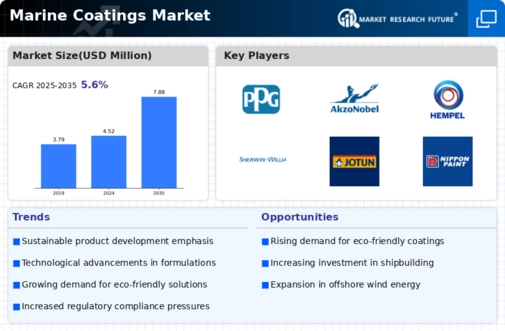Market Share
Marine coatings Market Share Analysis
In the dynamic and competitive Marine Coatings Market, companies deploy various strategies to establish and enhance their market share. Here's a breakdown of key positioning strategies:
Product Differentiation:
Companies aim to differentiate their marine coatings by offering unique formulations with specific properties such as anti-fouling, anti-corrosive, or anti-abrasive characteristics.
Developing specialized coatings for different marine environments, including saltwater, freshwater, and brackish water, to address varying corrosion and fouling challenges.
Introducing innovative additives or technologies to enhance performance attributes such as durability, adhesion, UV resistance, and color retention.
Market Segmentation:
Segmenting the market based on vessel types, including commercial ships, pleasure crafts, yachts, offshore platforms, and marine infrastructure, to better address distinct customer needs.
Tailoring product offerings and marketing strategies to target specific segments effectively, such as offering high-performance coatings for large commercial vessels or aesthetic coatings for luxury yachts.
Developing customized solutions for niche markets or specialized applications, such as coatings for ice-class vessels, chemical tankers, or offshore wind farms.
Brand Positioning:
Building a strong brand reputation by emphasizing factors such as product quality, reliability, technical expertise, and customer support.
Investing in marketing initiatives to raise brand awareness and differentiate from competitors, including advertising campaigns, participation in industry events, and digital marketing efforts.
Establishing partnerships with key industry players, shipyards, naval architects, and regulatory bodies to enhance brand credibility and trust among customers and stakeholders.
Cost Competitiveness:
Striving to achieve cost leadership by optimizing production processes, sourcing raw materials efficiently, and minimizing operational expenses.
Offering competitive pricing strategies to attract price-sensitive customers while maintaining profitability through economies of scale, supply chain efficiencies, and cost-effective formulations.
Providing value-added services such as technical support, application assistance, and maintenance solutions to justify premium pricing and differentiate from low-cost competitors.
Technological Innovation:
Investing in research and development to innovate and improve marine coating properties, manufacturing processes, and application techniques.
Leveraging advancements in polymer chemistry, nanotechnology, and surface engineering to develop coatings with enhanced performance attributes such as self-healing, hydrophobicity, and fouling-release.
Collaborating with customers, suppliers, and research institutions to stay at the forefront of technological advancements and address emerging market trends, regulatory requirements, and sustainability challenges.
Environmental Sustainability:
Responding to growing environmental concerns and regulatory pressures by developing eco-friendly and low-VOC marine coatings.
Investing in sustainable manufacturing practices such as waste reduction, energy efficiency, and water conservation to minimize environmental footprint and enhance corporate social responsibility.
Communicating sustainability initiatives and certifications to customers and stakeholders to enhance brand reputation, build trust, and capture market share in the growing green coatings market.












Leave a Comment